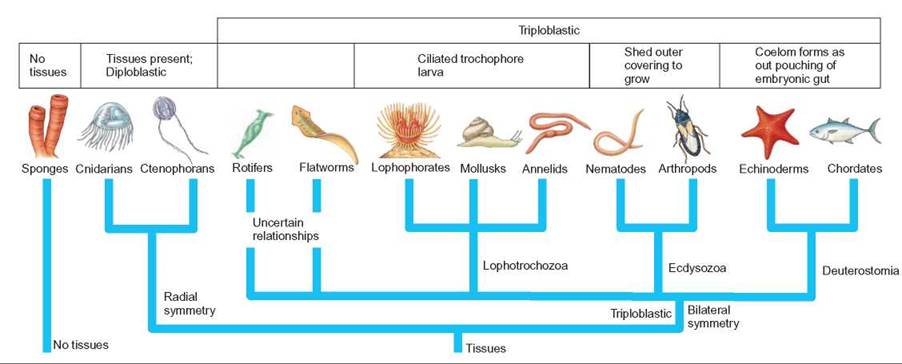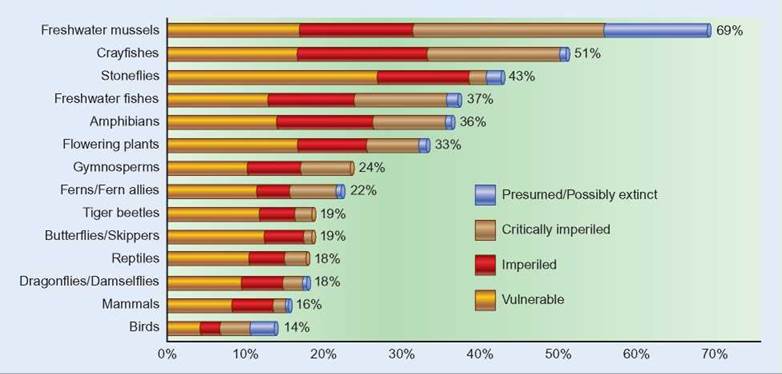CONCEPTS IN BIOLOGY
PART V. THE ORIGIN AND CLASSIFICATION OF LIFE
23. The Animal Kingdom
23.2. The Evolution of Animals
Scientists estimate that the Earth is at least 4.5 billion years old and that life originated in the ocean about 3.8 to 3.7 billion years ago. The earliest animal-like fossils date to about 600 million years ago. Most of the earliest animals were probably either small organisms that floated or swam in the ocean or wormlike organisms that crawled on the bottom or through the sediment on the ocean floor.
Because they lived in the ocean, these animals did not require special mechanisms to deal with rapid or extreme changes in the environment and they did not have a problem with dehydration. Because the concentration of salts in the early ocean approximated that of the animals’ cells, the animals did not need to expend energy to keep their cells in osmotic balance. Furthermore, their body temperature was that of the water in which they lived.
The early evolution of animals was rapid. Scientists have found examples of all the major groups of animals as far back as the Cambrian period, 540 to 490 million years ago. They were all marine animals, and many groups, such as sponges, jellyfish, mollusks, crustaceans, starfish, and many kinds of fish—are still primarily marine animals. The evolution of organisms that inhabit freshwater and terrestrial environments is a more recent development. The first terrestrial animals (arthropods) are found in the fossils of the Silurian period, 443 to 417 million years ago. Major changes in the kinds of terrestrial animals occurred after that time. Two groups—arthropods (particularly the insects) and vertebrates (especially reptiles, birds, and mammals)—were extremely successful in terrestrial habitats.
The evolution of animals led to great diversity, and today animals are adapted to live in just about any environment. They live in all the oceans, on the shores of oceans, and in shallow freshwater. They live in the bitter cold of the Arctic, the dryness of the desert, and the driving rains of tropical forests. Some animals eat only other animals, some are parasites, some eat both plants and other animals, and some feed only on plants. They show a remarkable variety of form, function, and activity. They can be found in an amazing variety of sizes, colors, and body shapes.
It is common to divide animals into two categories. Animals with backbones made of vertebrae are called vertebrates and include various kinds of fishes, amphibians, reptiles, birds, and mammals. Those without backbones are called invertebrates. All early animals lacked backbones, and invertebrates still constitute 99.9% of all animal species in existence today (Outlooks 23.1).
The evolution of animals is complex and often difficult to interpret. Figure 23.2 shows the current knowledge of how various groups of animals are related.

FIGURE 23.2. Animal Evolution
This diagram shows the current thinking about how the major groups of animals are related to one another. There are about 30 recognized phyla. Only the major phyla are shown here.
OUTLOOKS 23.1
The Problem of Image
We humans are vertebrate mammals. We unconsciously view all other animals by comparing them with ourselves. If other animals are like us, we feel we understand them and can empathize with them. If they are not mammals like us, we often consider them to be weird.
Mammals make up less than 0.04 percent of all the animals that exist; thus, mammals are a minor ingredient in the whole collection of animals in the world in terms of numbers and in significance. Because certain species are able to grab the attention of the public, often they are called charismatic species.
Our narrow, biased view of the world is evidenced in subtle ways. For example, most of the endangered species listed are vertebrate animals like us. About 7% of the known species of vertebrates are designated as endangered. On the other hand, less than 0.2% of invertebrate species are known to be endangered. The lack of invertebrates on lists of endangered species is primarily because we know so little about them. We don't even know how many different species there are, let alone if species are going extinct or not.
We have organizations to save whales, pandas, and wild horses (which are not endangered), but we do not have organizations to save the poison arrow frog or endangered native crayfish and clams. In actuality, in North America the most vulnerable category of organisms consists of freshwater species of mussels (clams), crayfish, fish, and stoneflies. The least vulnerable are birds and mammals, yet birds and mammals capture most of the public's interest and governmental financial support, and are highlighted by the U.S. Fish and Wildlife Service on its endangered species website.

Source: Data from Natureserve, Prescious Heritage.
23.2. CONCEPT REVIEW
2. Where did all the various groups of animal life originate?
3. How are invertebrates and vertebrates different?